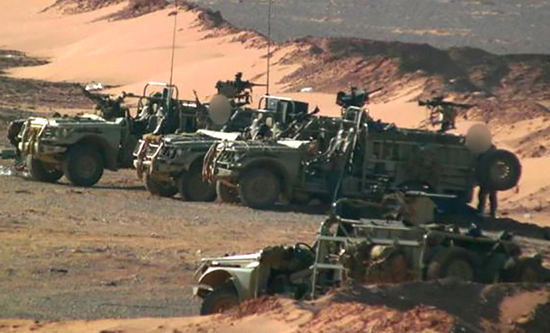
British forces in Syria
The declaration by Iraqi military forces of the liberation of Mosul, Iraq, from Islamic State (IS) forces on 9 July marks a major step in the defeat of the organisation’s once powerful caliphate in Iraq and Syria. The organisation now holds only 9% of the territory it held at its height in 2015. IS is not yet defeated, and the battle to remove it from the cities of Raqqa and Deir Ez Zor in Syria continues. However, as gains are made against IS, regional and imperialist actors are shifting their priorities to broader strategic questions. Syria, and the continuing war there, remains at the heart of a power struggle for influence across the region and beyond. The fight to retake important IS territory is central to the struggle between a weakening US imperialism, supported to different extents by other NATO powers, and the rising influence of Iran and Russia. This battle is being played out in a complex web of alliances and conflicts on the ground: from the fight for Kurdish autonomy, to a struggle between US and Iranian influence in south-east Syria, these conflicts look set to fragment the Syrian nation.
With territorial control in the Kurdish north-east and most of the west of Syria increasingly fixed, the battle for control of the remaining IS territory in the east is becoming the major flashpoint. From Raqqa, through Deir Ez Zor, control of this zone would give the Syrian government the opportunity to link up transport routes from Iran, via areas under Iranian influence in Iraq, through Damascus, and ultimately to Lebanon (home to Hezbollah) and the Mediterranean coast. Such a route would be a major coup for the expansion of Iranian influence and power across the region, and would strengthen all the ‘axis of resistance’ forces along it. For the US and its allies, blocking this route is imperative.
Forces from the Syrian Army (backed by the Russian air force), the US-backed SDF and IS, have converged at Raqqa. The SDF launched an offensive to eject IS from the city on 6 June, and is backed in this assault by US, British and French special forces. On 18 June, the US air force shot down a Syrian SU-22 plane near Raqqa, accusing Syria of bombing close to SDF forces. The Syrian military said it was bombing IS fighters. The response from Russia was to immediately cut off military ‘deconfliction’ co-operation with the US aimed at ensuring that their respective military forces do not inadvertently clash. The Russian Defence Ministry declared ‘All flying objects, including planes and drones of the international coalition, detected west of the Euphrates, will be followed by Russian air defence systems as targets’. Two Iranian-made drones have also been shot down by the US in similar situations.
The military base at Al Tanf has become another major arena of conflict. Al Tanf is a hub of US operations in training rebels, and controls the border crossing into Iraq. It has been in the hands of the US and their rebel groups since 2016, pre-emptively blocking another crucial land route to Iran. In August 2016 the BBC revealed pictures of British soldiers guarding Al Tanf base. The US military has unilaterally declared a 55km ‘deconfliction zone’ around Al Tanf. On 18 May, US planes bombed a column of Syrian government fighters, including Iranian and Hezbollah forces, approaching Al Tanf base, and again bombed Syrian forces, including tanks and other artillery in the area in June. These incidents have ratcheted up tensions between US and Russian military forces, increasing the chance of a wider conflict.
US President Trump and Russian President Putin met at the G20 summit in Hamburg on 7 July, and discussed implementing a new ceasefire in the south-west of Syria, in order to freeze areas of control. Greater military co-operation with Russia has begun, fueling anger from sections of the US ruling class. More recently, Trump has made clear that he has pulled funding for a covert CIA programme to arm Syrian rebels – leading to accusations that he has handed the country over to Russia. Whether this will affect the rebels in Al Tanf in unclear. However, he has also been the first US President to launch strikes openly targeted at the Syrian military, and has threatened further action on the strength of mysterious warnings of plans for chemical weapons attacks. The US House of Representatives approved new sanctions on Russia and Iran on 25 July.
The erratic US foreign policy in the Middle East under Trump reflects more than just his personal lack of strategy. There are real divisions within the US ruling class, not least over Russia. Further to this, allied regional powers are asserting a path more independent from US leadership. Whilst visiting Saudi Arabia in May 2017, Trump made his full support for the country clear, giving the go-ahead for Saudi to lead other Gulf States in a blockade of Qatar. Qatar is seen as being too close to Iran, and retaining pragmatic relations with the Syrian government – despite sponsoring Jabhat Al Nusra to overthrow it (Robert Fisk, The Independent, 6 July 2017). Turkey, primarily concerned about the US alliance with Kurdish forces, has begun to thaw towards Iran, Syria, and Russia. Iran remains the US’s preoccupation in the region. The current struggles could determine the alliances clashing in the next imperialist war in the Middle East.
Toby Harbertson
Fight Racism! Fight Imperialism! 259 August/September 2017




